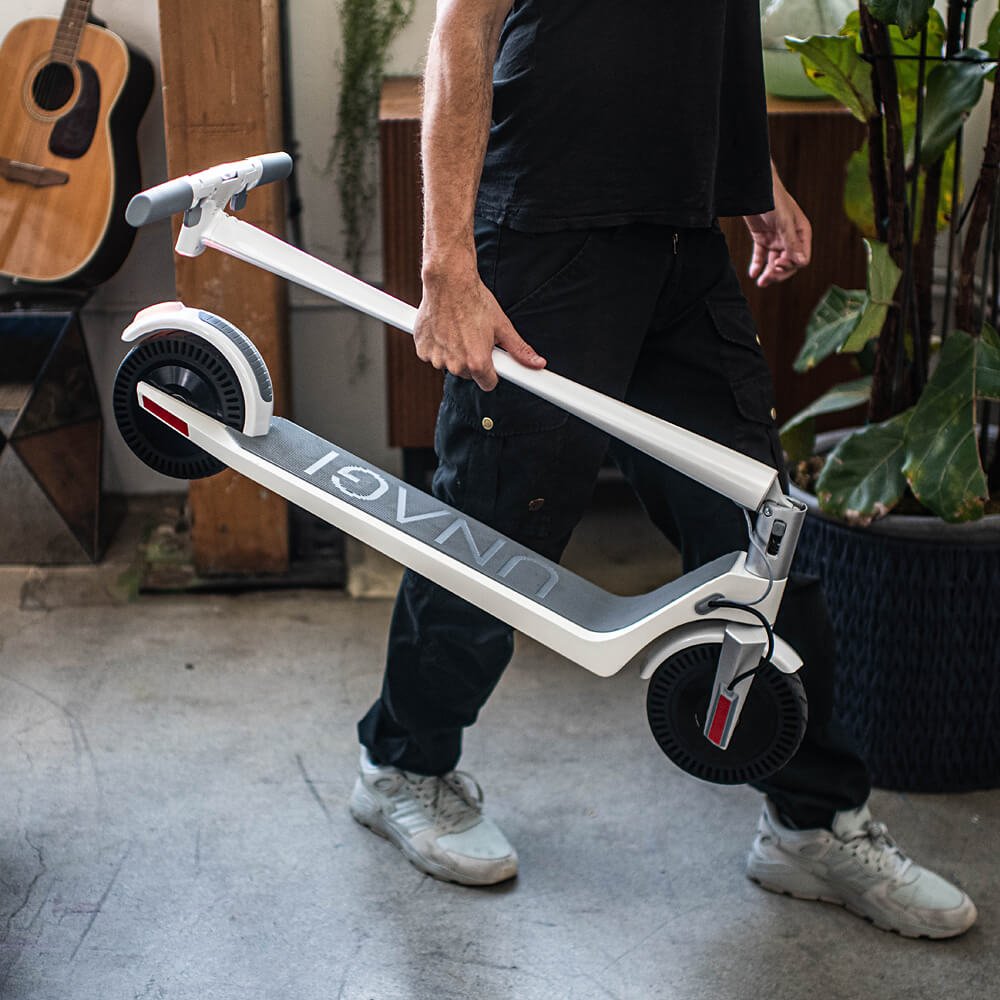Micromobility is here to stay, and it’s changing how we experience urban life for the better. With Unagi’s membership program, you can enjoy all the benefits of a top-tier electric scooter without the sky-high price of ownership or the inconvenience of ride-sharing.
They are compact, dependable, functional, and green and more people are falling in love with them. What are we talking about? The little joyrides popularly known as electric scooters, of course.
These two-wheelers have charmed their way into the hearts of many, thanks to their all-round functionality. However, there's one thing about them that doesn't sit well with the people who have grown so fond of them – their cost.
The cheapest electric scooter starts from as little as $100, with prices ranging up to $6800 for the most expensive electric scooter. For an average scooter, you can expect to pay between $500 to $1000. And for a last mile mobility device, that's still quite steep.
So why are electric scooters quite so expensive? Well, a scooter is the sum of its parts, and good parts don't come cheap.
Read on to find out what's behind an electric scooter price and why getting your hands on your favorite mobility device might force you to dig deeper into your pockets.
Breaking down the cost of an electric scooter

Before we get into why each individual element of an electric scooter costs so much, check out a rough estimate of how much each part of an e-scooter adds to the value of the device.
- Li-ion Battery – 25-30%
- Electric Motor – 10%
- Electric Charger – 10%
- Frame Construction – 8%
- Wheels + Tire Types –5%
- Quality of Components (handlebars, dashboard, LED Display, etc.) -10-15%
- Labor Costs – 5%
- Export/import Duty + Shipping Costs – 20%
- Other Factors – 10-12%
Let’s explore each one in more detail.
Li-ion Battery

The main reason electric scooters are so expensive is the type of battery it uses.
The battery is the most expensive component in an electric scooter, contributing up to 30% of the total price. And it’s easy to see why. A battery's power influences pretty much every performance aspect of an electric scooter.
Most modern electric scooters are powered by lithium-ion batteries. These batteries do not come cheap compared to other batteries such as lead-acid and Nickel Cadmium batteries.
Li-ion batteries may be smaller than their traditional counterparts, but they hold considerably more energy for extended periods of time.
Despite the market seeing a gradual decrease in the cost of lithium-ion batteries over the last ten years, rising costs of their raw materials continue to keep prices high.
Most li-ion batteries use cobalt as the negative cathode of the cells. Given the rarity of cobalt these days, it's fast becoming an incredibly expensive resource.
Cobalt prices have been on the rise due to increased global taxes and the fact that it is majorly found in the Democratic Republic of Congo, one of the most volatile regions in the world right now. This hinders the continuous supply of the precious metal, thereby making its price highly unpredictable.
Which begs the question, why are manufacturers still insisting on using these batteries? Well...
- Lithium-ion batteries have a faster charging sequence compared to their lead-acid counterparts.
- Despite their small size, they boast a high energy density. Meaning they can store vast amounts of power compared to other types of batteries.
- Unlike other scooter batteries, Lithium-ion batteries do not have a charge memory. This means you do not have to discharge the battery fully before recharging it to maintain its integrity fully. The result? Longer battery life and more money saved in replacement costs.
- At 99%, lithium-ion batteries have a higher charge efficiency. In comparison, lead-acid batteries have 85% charge efficiency meaning 15% of energy gets lost in the charging process. A lithium-ion battery saves you money on electricity bills and provides a more extended service.
Essentially, because consumers want longer battery life and a greater single-charge range, batteries that meet these specifications tend to have comparatively higher prices. The knock-on effect is increased scooter prices.
Electric Motor
Although the motor contributes only about 10% of the electric scooter cost, its specifications and power output can drive the price up by a significant margin.
Expressed in Watts (W), motor power determines many performance features of an electric bike. This explains why a model running on a 750-watt motor will cost almost twice as much as one with a power output of 350W.
There are a slew of benefits to choosing electric motors with a higher wattage. Higher motor power will usually result in:
- Higher top speed
- Better hill-climbing ability
- Greater load capacity
- To a lesser degree, a longer range
Another aspect of the motor that makes electric scooters so expensive is the actual type of motor used. Brushless hub motors cost more than brushed DC motors, for example.
As well as providing more torque on loads, brushless hub motors are more efficient, easier to maintain, have lower weight, and can weather the shocks and imperfections on the road for optimum performance, meaning electric scooters that come with these motors installed will cost significantly more.
Additionally, some electric scooter motors have special functions and configurations that further shoot the price up, such as:
- A regenerative braking system that converts some of the kinetic energy, otherwise lost when braking or decelerating, into electricity for recharging the battery.
- An electromagnetic brake that automatically engages as soon as you let go of the throttle for enhanced safety when riding an electric scooter.
- Specialized ball bearings designed to fit snugly inside a wheel.
To put it simply, the more features and functionalities incorporated into the motor, the higher the price of an electric scooter.
Electric Charger

The electric charger accounts for about 10% of an electric scooter’s price.
How does a charger drive up the price of an electric scooter, you ask?
In essence, all chargers do the same thing. However, power specifications, charging speeds, safety protection, and other features will vary according to the charger type. For instance, you can expect to pay more for an e-scooter charger that has a robust safety mechanism (short circuit, overcurrent protection, over-voltage protection, etc.).
Next, depending on how big your battery is, the nominal voltage required will range from 12.6V all the way up to 84V and more. As expected, the higher the power specifications, the pricier the charger.
Another thing that boosts the price of an electric scooter is the charging speed its charger supports.
There are three battery charging models available to e-scooter owners:
- Slow charging can take 8-12 hours to recharge an electric scooter. Ideal for overnight charging.
- Normal charging is the most common and will complete the task in 4-6 hours.
- Fast charging is the fastest way to charge an electric scooter. It can deliver up to 80% charge in just one-and-a-half hours.
Finally, the many other features of a charger can drive the price upward, for example if the charger has add-ons like multiple types of plugs (e.g. EU plug and UK plug), LED charging indicators, and more.
Frame Construction

Frame construction contributes an estimated 8% towards the scooter price. Much like a human spine or a motorcycle chassis, the frame holds everything together – motor, wheels, suspension, handlebars, you name it.
And so as a general rule, higher-end electric bikes will use sturdier, more expensive frame materials. And the build quality will be noticeable in the finishing touches.
The frames of most mid-price electric scooters can be made of industrial-grade aluminum alloy, carbon fiber, or a combination of both.
Carbon fiber is usually the best option when you want an e-scooter to be rigid, tough, and lightweight. It’s also the same reason carbon fiber is now being implemented in aircraft, vehicle, and manufacturing industries.
The most expensive electric scooters usually go a notch higher and use aerospace aluminum alloy, the same stuff used in building airplanes. This type of aluminum is lighter and feels more stable.
A handful of cheapest electric scooters will often use a bit of steel in their frame. However, if there is too much steel, the scooter gets too heavy to ride.
Wheels + Tire Types
Making up about 5% of electric scooters' cost are the wheels and types of tires. Scooter wheels will cost more or less depending on various elements, such as:
- Wheel diameter
- Polyurethane thickness
- Polyurethane hardness
- Core type
- Bearings
Similarly, the types of tires fitted in an electric scooter’s wheels will determine how expensive it is. For example, a cheap scooter will have solid tires on the front and rear wheels to keep the price low, and while they are puncture-proof and require less maintenance, they come at a cost to ride comfort. Saying that, solid tires are a good fit if you live in a place with poor roads.
Pneumatic tires, also known as air-filled tires, are a staple of the more expensive electric scooters. Designed to even out rough terrain, these tires do not come cheap. But because they’re filled with air, they provide more comfort, greater stability, better suspension, more traction, better climbing, and better overall control.
Quality of Components

Another major contributor to the high electric scooter prices is the quality of components. You might have to fork out about 10-15% more to get your hands on a scooter with premium quality components.
Speaking of components, these can comprise both electronic and non-electronic parts. Let’s take a look at a few of them in more detail:
Handlebar
A good handlebar is made of handles with grips and controls designed for ease of use. The most expensive scooter will use silicone over plastic or rubber for added grip.
The handlebar also houses other features like the display screen, accelerator and brake controls. You might need to pay more depending on the quality of these features.
For example, in a higher-end scooter, the display screen will not only show your current speed and travel mode, but also battery level, error messages, and more.
Lights
Most electric scooters come with a built-in LED headlight and a tail light for illumination during night rides. Expensive scooters will often include multi-colored LED lights on either side of the deck to add more style and visibility to the scooter.
Braking System
Most high-end and fast electric scooters will usually come with quality braking systems. For stronger braking power, their systems often combine a mechanical disc brake with optional foot and electronic brakes.
Suspension
A cheap electric scooter won't come with a suspension system. But a higher-performance model will have a beefy coil-over-hydraulic suspension to dampen bumps in the road and improve the ride quality.
Other Factors

It’s not just the price of component parts that push up the price of electric vehicles. Other factors that are purely external also contribute toward the cost of the e-scooter, including:
Shipping Costs
Electric scooters aren’t typically built in the country they’re sold, meaning to get them to the end user, they have to be shipped. And that cost has to be covered.
Labor Costs
E-scooters aren’t manufactured by fairies, employees need to be paid for their hard work. The cost of labor includes wages for all workers on an assembly line as well as benefits and payroll taxes.
Research and Development Costs
One big reason electric scooters are still expensive is that they’re a relatively new technology. Development research is still ongoing, the costs of which are passed onto the consumer.
Import Duty Costs
Import duty costs vary by the taxation laws of a given administrative region. Depending on the region you are in, import duty costs can push the scooter price up by up to 20%.
Conclusion
Not all electric scooters are incredibly expensive, depending on what you want from your ride, there are several great value electric scooters that deliver fast and comfortable rides at an affordable price.
Can’t afford to buy your own top of the range expensive electric scooter? Good news - you don't have to go without... You can rent a premium scooter for as little as $39 per month!
So what's stopping you from investing in the lastest eco friendly mode of transport?

Stay current with the latest U.S. electric scooter laws in our 2025 guide. Updated annually since our first comprehensive guide, ensuring you have the most recent state and city regulations to ride responsibly”

The Slack Core 920R is currently the fastest electric scooter in 2025 that you can purchase without the need for pre-order.

Our selection of the best electric scooters 2025 spans the fastest e-scooters to the most portable ones, the ones designed for city riding and off-road, the best scooters for rain, budget electric scooters for students, and more powerful ones for skilled riders.

The Unagi Voyager is the best lightweight electric scooter for adults and teenagers. It is the ultraportable sequel to its predecessor, the Unagi Model One Classic.

If you're wondering whether an electric scooter with a seat is right for you, this is a detailed article that would suit your need.

Understand which personal electric vehicle is best, the choice between an electric bike or electric scooter might already be made for you by some critical factors, including portability and storage capacity.

In the U.S., most states don't require a license. For those that do, they usually just ask for a regular driver's license or a learner's permit.

Yes, you can bring an electric scooter on a plane, but it needs to have a lithium battery smaller than 100 watt-hours, which most don't.

Manufacturers advise against riding electric scooters in the rain. The main reasons are: water can fry the electronics, make the ride dangerous, and void your warranty.

The basis and the premise of my work is that we either operate out of love or we operate out of fear...Time is currency. The coolest thing about the scooters is that it's really quick, and it goes uphill. From there, traveling more efficiently and having a good time doing it--I think that's the most important thing.

Cynthia Leu has a full plate. A tech worker by day, Cynthia spends her off time balancing the parallel lives of a powerlifter, entrepreneur, mental health advocate, and more. Riding Unagi helps this USMC veteran cut down on everyday…

https://www.youtube.com/watch?v=7m2hVBE62LY Rasheed Muhammad is sick of Los Angeles traffic. In order to preserve his sanity, Rasheed has traded his everyday driving habit for the portable and beautiful Unagi Model One. It’s an essential accessory for navigating LA streets -- and…

Rich Lee, Co-Founder of San Francisco’s SPRO Coffee Lab, wants to share his love for coffee with the world. He depends on riding Unagi to avoid the hassle of navigating the parking crunch in the booming Mission Bay neighborhood.…












